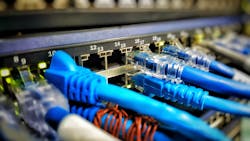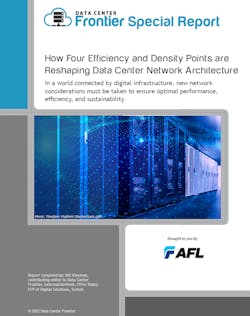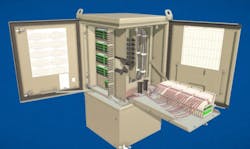Four Key Data Center Cabling and Networking Design Considerations
This concludes our article series on efficiency and density points that are reshaping data center network architecture.
In the colocation market, tenants need the ability to add capacity on demand, the capability to scale networks across the globe, and the agility to make high-speed connections with cloud and service providers as and when required. For colocation providers to compete and modernize, the physical layer should provide flexible, scalable, high- performance fiber infrastructure designed to support increasingly demanding applications and customer requirements.
As mentioned, cabling and networking systems supporting our most critical environments are essential to modernization. However, not every fiber connection or cabling system is built the same. Here are four key efficiency design considerations when working with modern networks:
1. Density
Networking and cabling carry the lifeblood of our digital infrastructure. We use these systems for critical communication. However, a significant part of this is fitting as much as possible into smaller spaces. Today, the main focus of communication technologies infrastructure is size reduction — including fiber optic cables. Higher fiber counts in smaller cable packages are in high demand. A good partner will play a significant part in creating this movement to increase fiber-dense cable concepts and participate internationally to promote the value of high-density cabling with real cost-saving opportunities. For example, AFL’s MicroCore® cable family offers one of the industry’s most diverse and highest fiber density product offerings. MicroCore® cabling forms the backbone of high-tech networks installed in applications ranging from the Local Area Network to the most complex data center environments.
2. Flexibility
Flexibility refers to the ability of a network to adapt to changes. An expandable network — an 864-fiber backbone versus 432 — does not necessarily solve all the problems. This is because the specific nature of network demands is hard to predict. What if a disruptive wireless service provider comes in, installs 5G nodes at certain locations, and looks for front- haul and back-haul services? Merely having those 432 dark fibers running near the sites does not help.
Fortunately, developments in splice closures, terminals, hubs, and other components provide modular and highly flexible solutions that enable the network to adapt. Does the customer need one fiber per location? 12? Two fibers, but with multiple wavelengths? With these network components, the network can be readily configured to accommodate a wide range of scenarios, ensuring that the network operator can accommodate future customers’ needs — even without knowing right now what those needs will be or where.
Through partnerships with premier optical fiber manufacturing companies, a good partner must be able to offer the highest- performance optical fiber to enable the most demanding applications.
Remember, your data center must be flexible to meet your customers’ needs. Flexibility becomes even more critical for multi-tenant data centers (MTDC). Design flexibility and industry-leading performance are a must when reviewing a cable offering. Through partnerships with premier optical fiber manufacturing companies, a good partner must be able to offer the highest-performance optical fiber to enable the most demanding applications.
3. Expandability
Expandability refers to the ability of a network to handle increased traffic in the future. The simplest way to do this is to deploy more fiber. There is an expense to this, though, in terms of increased cable purchasing and installation costs. Fortunately, vendors are mitigating this problem. New, compact ribbon cables enable the deployment of far more fibers than ever in the same footprint. For example, it is now possible to deploy an 864-fiber cable in the same size pathway to accommodate 432 fibers. That means network operators can deploy twice the fiber but still use the same duct, the same installation method, etc. Rather than paying 100% more for a 100% capacity increase, the total installation cost increases by a much smaller amount. New fusion splicing technology further reduces incremental installation time and costs. Your cabling partner must be able to support expandable networking and cabling solutions.
4. Accessibility
We’re going to stay on this point because it’s essential. Once you deploy your cabling infrastructure, it’s critical to access and manage it as needed. For example, working with individual pathways gives you increased security, a more straightforward configuration around specific needs, much easier moves, adds, and changes, and you significantly minimize post-install access requirements.
With that in mind, accessibility refers to the ability of technicians to go in and make critical network changes. It is one thing for a physical access network to be theoretically capable of adapting to accommodate new capacity demands, WDM, etc. But someone must go out and make those changes, preferably make them quickly, and do so without disrupting existing customers. Here, too, vendors now offer highly modular and craft-friendly network components to enable these capabilities.
The best way to understand accessibility is with a real example. The image here shows a design of one network component, in this case, a fiber distribution hub, illustrating how manufacturers can enable flexibility and accessibility in networks. The hub can support various split ratios, WDM, a mixture of point-to-point and PON connections, etc. — all simultaneously. Its design allows technicians to quickly come in and make those changes by swapping out components, reworking splices, adding pass- through connections, or whatever else is needed.
In summary, we can no longer view the physical access network as a static part of our network model. The pace of change and potential future opportunities is too great for us to ignore the dynamic nature of physical access network demands. Network operators must consider this. They need to plan for expandability, flexibility, and accessibility
in their networks and seek design, engineering, installation, and hardware partners who can help them achieve this.
Before we wrap it up here, there is one more critical consideration.
BONUS: Sustainability. Efficiency, modernization, and green solutions go hand-in-hand. However, too often, ensuring that your design is green or sustainable is left until the end of an architectural discussion. Going green isn’t only good for the environment; it’s also great for business. There have already been numerous studies indicating that going green and efficiently using energy is excellent for the company. For example, a recent study shows that S&P 500 organizations with sustainability initiatives and technologies built into their overall strategy will outperform those without. According to the report, these organizations see an 18% higher ROI because of how efficiently they manage and plan for climate change and energy utilization.
“You will perform better financially by doing things like having a great sustainability program.”
— Jeffrey Hollender, professor of sustainability at NYU Stern
Regarding sustainability, look for cabling and networking partners that have taken steps to become more environmentally friendly. When selecting a partner, look for, for example, voluntary partnerships with the ENERGY STAR Program. A leading partner will work to improve energy efficiency and fight climate change through a strategic, corporate energy management program that enhances the organization’s financial health and help preserve the environment for future generations.
You’ll see direct business and infrastructure benefits when applying these fundamental considerations.
Consider the following.
Networking and data center architecture: Seeing the benefits
Once you apply the considerations above, your infrastructure will thank you. In working with a good networking and cabling solution, there are a lot of positive outcomes. This includes the following:
- Improving time-to-market, speed-to-deployment, and reducing waste. When working with fiber optics and cabling, it’s critical to leverage the right components to get you up and running quickly. For example, solutions like Mass Fusion Splicing create time-to-market, speed-to-deployment, and waste reduction benefits. Internal studies have estimated that data center operators see up to an 89% reduction in splice time. Remember, as fiber counts increase, single fiber splicing becomes unrealistic. This is especially the case for larger colocation and MTDCs.
- Improving performance. Modern cabling options are designed to reduce latency and improve the performance of critical applications within a data center. For example, new cable families offer diverse and some of the industry’s highest fiber-density product offerings. Through partnerships with premier Optical Fiber manufacturing companies, partners like AFL offer high-performance Optical Fiber to enable the most demanding applications. High-density horizontal trunking solutions and lightweight, high-performance vertical runs support modern data center applications and allow technicians to deploy critical infrastructure even faster.
- Reducing complexity and reducing errors. While we mentioned this earlier, it’s critical to discuss this again. Errors and complex deployments will slow down the operations of a data center facility. Working with designs that simplify deployment and simplify operators’ lives is essential. But what happens when you inspect the wiring when everything is deployed? Specifically, what if you had to conduct a connector and bulkhead inspection? In this case, work with tools that holistically simplify the inspection and remediation process. Plug-and-play cabling systems have been instrumental in speeding up and simplifying fiber network deployment, first in hyperscale and enterprise data centers and now in 5G and FTTx networks. Since contaminated connectors remain one of the primary causes of network failure, the need to rapidly inspect and validate fiber end-faces for cleanliness has become critical. To make this validation easier, look for easy-to-use tools like the FOCIS Lighting2, which features a self-contained, palm-sized design and one-button operation, making inspecting crowded fiber patch bays quick and easy. A large, high-resolution LCD touchscreen improves the visibility of MPO and single-fiber connectors for advanced analysis.
- Supply chain improvements. Having the best components in your data center is key to success. However, what happens when something breaks and you don’t have a replacement? Partners like AFL improve the reliability of the supply of fiber optic cables to customers and provide even greater customer service by localizing supply and manufacturing. Looking for a partner that can think globally and execute locally would be best.
- Better collaboration with general contractors. You could have the best cabling system in the world. But what happens when no one knows how to service or install it? Your cabling and networking solutions are only as good as the installation. Partners like AFL have a distinct history of working with general contractors and installers. With concerns around time-to-market, it’s vital to have good people capable of supporting your critical infrastructure. Working with a partner with established relationships with GCs is a significant consideration and a big benefit when you pick the right solution.
Colocation data centers represent the frontier where hyperscale, cloud, telecom, and enterprise worlds interconnect. A colocation fiber network can quickly become challenging to manage if not properly maintained, and this can be prohibitive for end- users seeking to connect to new carriers. Effective infrastructure means end-users can cross-connect quickly, save on labor costs and time, generate revenue faster, and provide the agility to offer various cost-generating services to their customers.
Download the entire report, How Four Efficiency and Density Points are Reshaping Data Center Network Architecture, featuring AFL, for an exclusive real-world industry use case.
About the Author





